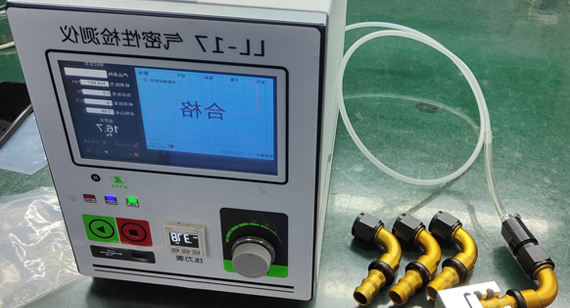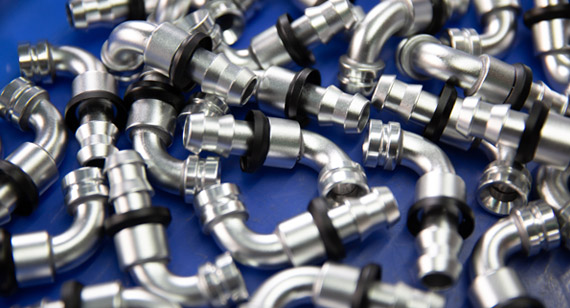15 years one-stop China custom CNC machining parts factory

Hey there I’m VMT Sam!
With 25 years of CNC machining experience we are committed to helping clients overcome 10000 complex part-processing challenges all to contribute to a better life through intelligent manufacturing. Contact us now
 165 |
Published by VMT at Jan 02 2024
165 |
Published by VMT at Jan 02 2024

Introduction:
Airtightness testing is a critical step in ensuring the quality and reliability of CNC-machined parts. However, various challenges often arise during the testing process, affecting the accuracy of results. In this article, we will explore common issues encountered in the airtightness testing of CNC-machined parts, providing insights and solutions to enhance the efficiency of CNC manufacturing facilities.

1. Equipment-Related Challenges:
One prevalent issue in airtightness testing is related to equipment. This may include inaccurate pressure gauges, malfunctioning air pumps, or issues with gas cylinders. Regular equipment maintenance and calibration are crucial to mitigate these problems. CNC manufacturing facilities should establish a routine maintenance schedule to ensure the accuracy and reliability of testing equipment.
2. Part Preparation Issues:
Another common hurdle arises during the preparation of CNC-machined parts for airtightness testing. Inadequate cleaning and drying processes can lead to false results. To address this, CNC manufacturing facilities should emphasize the importance of meticulous part preparation, ensuring that parts are free from contaminants and moisture before testing.
3. Installation and Connection Problems:
The installation phase introduces challenges related to improper mounting and connections. If CNC-machined parts are not securely and tightly connected to the testing equipment, air leakage may occur, compromising the accuracy of the test. Rigorous checks during the installation phase and regular inspection of seals and gaskets can prevent such issues.
4. Pressure Fluctuations:
Stabilizing pressure during the testing phase can be challenging, leading to fluctuations that affect the reliability of results. This issue may be caused by leaks, temperature variations, or insufficient stabilization time. CNC manufacturing facilities should implement protocols for extended stabilization periods and conduct thorough inspections to identify and rectify any leaks promptly.
5. Interpretation of Test Results:
Interpreting test results accurately is crucial for making informed decisions about the quality of CNC-machined parts. Misinterpretation of results may lead to false positives or negatives. Training personnel to understand and analyze airtightness test data is essential. CNC manufacturing facilities should invest in training programs to enhance the skills of testing personnel.
6. Recordkeeping and Documentation:
Inadequate recordkeeping and documentation practices pose challenges for CNC manufacturing facilities. Accurate and comprehensive records are essential for traceability and analysis. Implementing a robust documentation system that includes testing time, personnel involved, equipment used, and test data will aid in troubleshooting and continuous improvement efforts.
7. Inaccurate Test Results:
Inaccurate test results are one of the most common issues in airtightness testing. This can be due to factors such as the low accuracy of testing equipment, improper operation, or environmental influences. To address this, high-precision and stable testing equipment should be selected, testing procedures strictly followed, and environmental factors controlled to minimize their impact on test results.
8. Inaccurate Leak Localization:
Sometimes, inaccurate leak localization occurs during airtightness testing. This may be due to inappropriate choice of testing equipment or unreasonable test parameter settings. To improve the accuracy of leak localization, suitable testing equipment should be selected based on the characteristics of the parts. Additionally, proper test parameter settings and the use of complementary detection methods, such as ultrasound or fluorescence testing, can help accurately locate leaks.
9. Unstable Inflation Process:
An unstable inflation process is also a common issue in airtightness testing. This may result from equipment malfunctions, poor gas quality, or leaks in the pipelines. To address this, regular checks and maintenance of inflation equipment, ensuring gas quality and pipeline sealing, along with the use of appropriate buffering devices, can minimize the impact of gas on test results.
10. Poor Reproducibility:
Poor reproducibility refers to inconsistent test results for the same part at different times or with different operators. This may be due to variations in operator skill levels, unstable equipment performance, or changes in environmental factors. To improve reproducibility, enhanced operator training and skill assessment, ensuring equipment performance and stability, and controlling the testing environment to reduce environmental variability are essential.
11. Low Testing Efficiency:
Low testing efficiency may result from insufficient equipment, cumbersome operational procedures, or long testing cycles. To enhance testing efficiency, facilities can increase equipment numbers for parallel testing, streamline operational procedures by eliminating unnecessary steps, adopt rapid airtightness testing techniques, and optimize production planning and logistics management for a more efficient workflow.
12. Environmental Contamination:
The gases and cleaning agents used in the airtightness testing process may contribute to environmental contamination. To minimize environmental impact, environmentally friendly gases and cleaning agents should be chosen. Additionally, strengthening the management of exhaust gases and wastewater, ensuring compliance with environmental regulations, and regular equipment maintenance and cleaning to reduce unnecessary waste and emissions are necessary measures.

Conclusion:
CNC-machined part airtightness testing is a crucial aspect of ensuring product quality in CNC manufacturing facilities. By addressing and overcoming common challenges related to equipment, part preparation, installation, pressure stabilization, result interpretation, and documentation, and through continuous improvement and optimization of airtightness testing processes, accuracy and reliability can be enhanced, providing assurance for the quality and reliability of CNC-machined parts. Continuous improvement initiatives, regular training, and proactive maintenance are key to mitigating these challenges and ensuring the production of high-quality CNC-machined parts.
Ready To Start Your Next Project?
Get Instant Quote

Request a Free Quote
Send us a message if you have any questions or request a quote. We will get back to you ASAP!